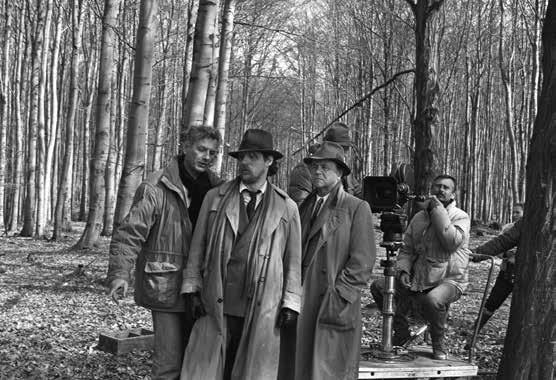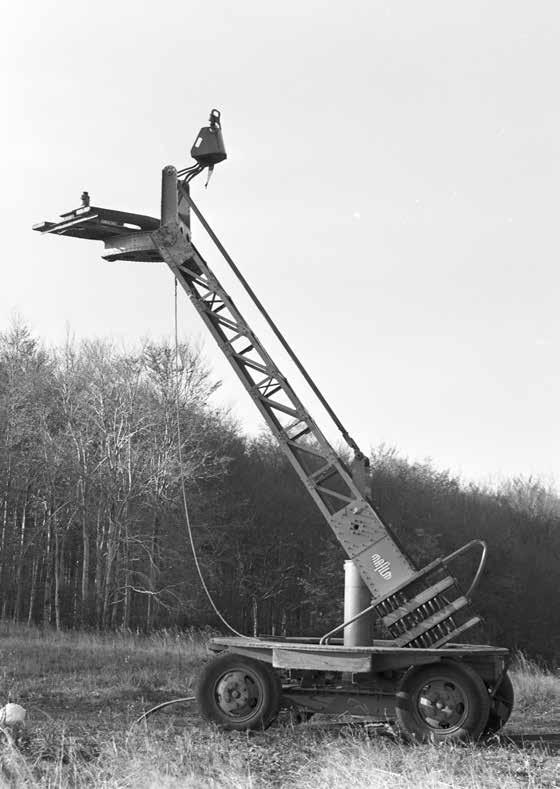SZÜRKÜLET (1990) directed by GYÖRGY FEHÉR
4K RESTORED VERSION


4K RESTORED VERSION

Directed by György Fehér
Screenplay by György Fehér using the motifs of Friedrich Dürrenmatt’s novel ‘The Pledge’ adapted for screen as It Happened in Broad Daylight
Cast
Péter Haumann
János Derzsi
Gyula Pauer
Judit Pogány
László Németh
Miklós Székely B
Kati Lázár
István Lénárt
Pál Hetényi
Director of Photography
Miklós Gurbán
János Kende
Gábor Medvigy
Peter Benya
Music
László Vidovszky
Sound
János Réti

Péter Kardos
Sets
Tamás Vayer
Costumes
Gyula Pauer
Edited by
Mária Czeilik
Genre thriller
Production Studio Budapest Hungarian Television
Technical spec 35 mm, black & white 97 min
Format
1:66:1, 4K RESTORED by the National Film Institute Hungary Film Archive & FilmLab
DIGITAL GRADING SUPERVISED
by Miklós Gurbán, Director of Photography
Awards
1990 Hungarian Film Week: Special Prize of the Feature Film Category
1990 Locarno International Film Festival: Bronze Leopard Award for Photography – Miklós Gurbán
---------------------------
1991 Strasbourg International Film Festival: Grand Prix ---------------------------
1991 Hungarian Film Critics Award Special Prize
Photos by Alice Inkey / NFI
The film pans across a dark forest from above in a slowly rising shot until a faint light appears above the mountains. Rain pours down. The forest conceals the body of a young girl. Two detectives are investigating a serial killer on the loose in a story set in an undefined place and time. The suicide of the only suspect prompts the detectives to reach different conclusions and use different methods. However, their traps fail. The killer remains at large in the rain-soaked vastness, which the camera dwells on at length, scanning across it for secrets.
György Fehér uses thriller elements as a pretext to speak about the opaqueness of the world, the ontology of sin and the infinite narrowing of perception in pictures of the landscape. The mournful choral music by László Vidovszky, one of the leading figures of the contemporary Új Zenei Stúdió (New Music Studio), intensifies this endeavour.
The film draws the viewer into the space and does not close down, instead it comes to an end in time; the world itself becomes an occurrence.
Shooting was completed in the summer of 1989, which is why Szürkület is often called the first feature film of the change of regime. It was edited three times. In 1990, it won the special prize of the professional jury of the 22 nd Hungarian Film Week, when the first prize was not awarded. International premieres were staged in 1990. It achieved its greatest success in Locarno where cinematographer Miklós Gurbán won a Bronze Leopard for photography, then it took the Grand Prix at the 19 th Strasbourg International Film Festival (1991).
Szürkület is a striking work of the so-called Hungarian ‘crime series’ or ‘black series’. Besides Kárhozat (Damnation, by Béla Tarr, 1987) that launched the trend, other major works here include Céllövölde (Shooting Gallery, by Árpád Sopsits, 1989), Árnyék a havon (Shadow on the Snow, by Attila Janisch, 1991), Gyerekgyilkosságok (Child Murderers, by Ildikó Szabó, 1992) and Woyzeck (by János Szász, 1993).
Similarly to his role models István Szőts and Zoltán Huszárik, György Fehér made only two full-length feature films, yet he wrote his name into the history of Hungarian film as one of the modern innovators of film language. The international success of Szürkület was preceded by several decades of experience in television. Fehér made the film when he was 50.
The Béla Balázs Prize laureate, Merited Artist graduated from the Academy of Drama and Film Arts, faculty of directing-cinematography of Károly Makk, in 1972. By the time he could work on Szürkület, he had already participated in making more than 50 television films as scriptwriter, cameraman and director.

He first created a stir with his exam films: Öregek (Elderly, 1969) edited into the compilation Hat bagatell (Six Bagatelles) was one of the earliest successful works of young documentary filmmakers exhorting a ‘Sociological Film Group!’ at the Béla Balázs Studio. His diploma film became an instant legend in Hungarian television-making. He had the actors in Shakespeare’s most bloody royal drama, Richard III, play virtually exclusively in close-ups and extreme close-ups (1973). Generally he contained the tension of opposing forces in a single picture. Ben Johnson’s Volpone and his TV opera Barabbás based on the work by Frigyes Karinthy were also made using this method. Many of his film plans never saw the light of day: for example, adaptations of Chekov and Dostoyevsky, and Franz Kafka’s The Trial. His greatest success came with his movie Szenvedély (Passion) shot in 1998. The film made a virtual clean sweep of the prizes at the Hungarian Film Week (1998), in Palic, Trieste, Brussels, and his lead actor, Péter Haumann, won the prize for best male character at the Taormina Festival.
György Báron, one of the foremost film critics in Hungary, wrote the following about Fehér: “I know only a few filmmakers – one of them is definitely Carl Theodor Dreyer – who could penetrate human faces to such depths as György Fehér. He was virtually the only one who, consciously, programme-like, turned to his advantage the TV poverty (primarily spatial and time constraints, and not a lack of money), building a consistent oeuvre out of it and by it. (…) If there is one director who gets the most out of his actors every time and in every situation, then that is György Fehér. Each and every moment of his movies and TV shows is equally serious and composed.”
György Báron: Az üres erdő. Színház, 2002/9
“I don’t like thrillers. The novel, The Pledge, caught my attention because I saw in it a Greek tragedy. I saw an opportunity to film the elusive… That’s what I would like to do, to film the intangible…. It would be completely senseless to go in the American direction. As far as I am concerned, the only solution is to make films that one can only make in Hungary. Films that are exclusively Hungarian.”
Interview with György Fehér. Neuwsblad Van Het Noorden, 4 November 1991
--------------------------------------------
“I want to show to what extent the search for justice stands in ridiculous contrast to the eternity of nature. Meanwhile, it is precisely this search that I am so fascinated by.”
Het Parool, 20 December 1991
--------------------------------------------
“Let’s look at what this film is: a spectacle. And this black & white, extremely gaunt film truly has a visual world. Even with the introduction of the protagonists: we see two human heads immersed in dark, sitting in a car. For a long time they remain faceless. The car stops but, like in an early Bresson film (or like in a late Bresson film), the camera – with dumbfounded wonder – ‘stays in place’ and does not track the passengers as they get out of the car. Instead of faces, we see the windscreen wipers. Then another passenger climbs out. This figure also remains faceless, with the camera showing the characters only up to knee height for a long time.”
Gergely Bikácsy: A vereség füstje. Szürkület. Filmvilág, 1990/11.

“There are certain pictures or settings which get to a point –this also is a dramaturgical process –where the camera does not see, the viewer does not see, because we do not see into the darkness that is the nature of man.”
Péter Balassa: Gyűlöletszerelem. Korunk 1991/4
--------------------------------------------
“We follow the horrific events with near indifference while feeling a rising sense of anger from minute to minute precisely because the director uses this story about the deadly danger threatening children for nothing more than stylistic posturing…”
Wiener Zeitung, 11 October 1990
--------------------------------------------
“Scripter-director Fehér insists on denying the audience any satisfaction whatsoever, focusing exclusively on the obsession and refusing to introduce any kind of evidence that would lead the case forward. On the other hand, he is lavish with dark moods. The magnificent images of wintry Hungarian landscapes in the mist of rain beating down relentlessly, the isolation of the barren trees and the hardened faces of peasants could easily make a perfect album of artistic black & white still photos of the highest order.”
Edna. Variety, 21 February 1990

György Fehér was Béla Tarr’s mentor. Even though he is at the heart of Béla Tarr’s work — and had a major influence on Bela’s stylistic shift in the ’80s — he has always remained in the shadows. He made two films, Szürkület and Szenvedély. They are incredible films, masterpieces. Hell on Earth. László Nemes on the Son of Saul.



National Film Institute Hungary Film Archive & FilmLab
30 years together in film preservation & restoration
217 features, documentaries, newsreels, shorts and animations

Nitrate and safety negative and positive preparations
DFT Scanity wetgate
Image restoration (Diamant Phoenix, Loki)
Baselight Color grading
Klang Sound Scanner
MWA scanner
Sondor audio digitization
Protools with restoration plugins
DCI & broadcast mastering
HUNGARY FILM ARCHIVE HUNGARY FILMLABNATIONAL FILM INSTITUTE HUNGARY FILM ARCHIVE
info.filmarchiv@nfi.hu
György RÁDULY Director





raduly.gyorgy@nfi.hu
phone: (+36) 20 259 4965
Tamara NAGY
International Sales Executive nagy.tamara@nfi.hu
phone: (+36) 20 259 2835
NATIONAL FILM INSTITUTE HUNGARY FILMLAB
filmlab@nfi.hu
Tamás BÓDIZS Director
bodizs.tamas@nfi.hu
phone: (+36) 30 948 1807
Balázs TÓTH

Head of Digital Restoration toth.balazs@nfi.hu
phone: (+36) 20 284 8149